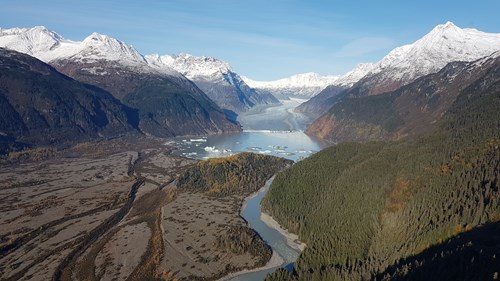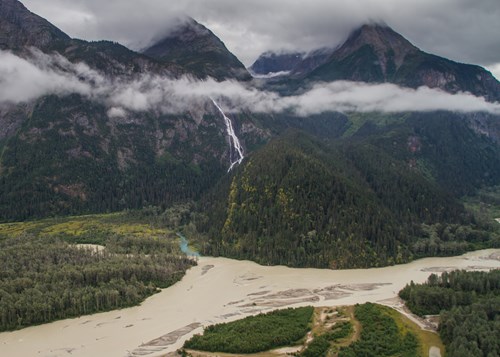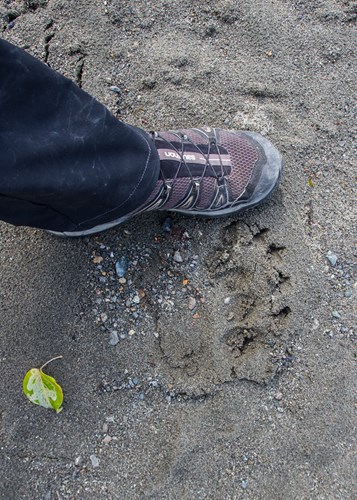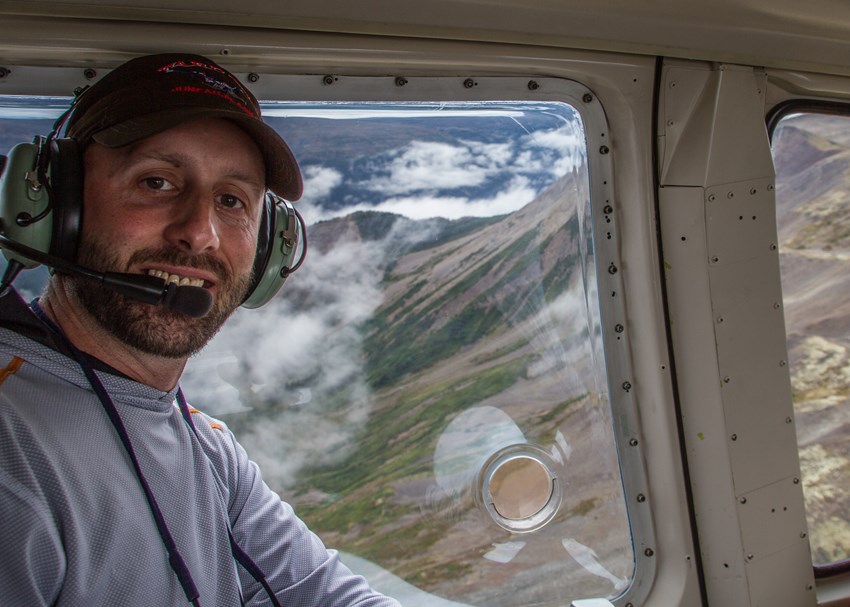The Ally in Alaska: A Conversation with FLBS Researcher Chris Sergeant
Chris Sergeant first joined FLBS in 2018 to extend fellow FLBS scientist Erin Sexton’s transboundary research in watersheds along the U.S./Canadian border. But while Sexton’s work primarily focuses on the shared transboundary watersheds between British Columbia, Alberta and Montana—where she’s investigating the terrestrial and aquatic impacts of energy development in the Flathead and Elk/Kootenai Rivers—Sergeant’s research is farther north, to the shared transboundary watersheds of Alaska and British Columbia.
His work is focused on three watersheds, which are home to the Taku, Stikine, and Unuk Rivers. Together, these watersheds occupy an area larger than the country of Ireland, and generate nearly $50 million per year through recreational use and fisheries-related activities. FLBS initially conducted salmon research on the Taku and Stikine Rivers during the SaRON project (2006-2008), so this isn’t the first time the Bio Station has been up that way. But the area has been subjected to mining, both historically and currently, leaving behind a messy legacy of potential impacts to the freshwater ecosystems that Sergeant is determined to unravel.
Toward the end of September, Sergeant made his first trip to Yellow Bay since joining the Bio Station’s team of researchers. During his stay, he was kind enough to make time to sit down with Media and Information Specialist Ian Withrow for an interview that covered everything from his complex transboundary mining research to his experiences working alongside Alaskan Brown bears. But it was Sergeant’s encounter with a massive, chicken-devouring bull trout that truly gave the conversation the appropriate Halloween feel…

Sergeant and his fellow researchers prepare for a day of field work at Whitewater Creek near the New Polaris Mine in British Columbia, Canada.
So Chris…thanks for taking the time.
For sure.
Now, you’ve been working as a researcher for the Bio Station for about a year, now. But this is the first time you’ve actually been to the Bio Station?
Yep, this is my first time. I’ve been to Kalispell once, I think in the early 2000s for a workshop about the Kokanee Salmon in Flathead Lake. Kokanee were such a big deal, then, and I was working on more lake fish stuff. But that’s as close as I ever made it to the Station. I’ve never been on the grounds until this week.
Where are you from originally?
I grew up in Des Moines, Washington, which is just south of Seattle. That’s actually where I did my undergrad and masters work, too. At the University of Washington.
And now you live in Alaska?
I do. My family—we moved there in 2011, so it’s been about eight years. Which according to the locals doesn’t quite make us Alaskan, yet.
You’ve got to earn it up there, huh?
Oh yeah. In Alaska, you’re not an Alaskan unless you’ve lived there for like 30 years.
How do you like it?
It’s an amazing place to raise a kid. We have a five-year-old and he loves it. The people are really nice and it’s extremely beautiful. It can be a little tough living in a place that doesn’t have roads in or out, because we’re in Juneau and the only way to get there is by boat or plane. So sometimes it can feel a little claustrophobic. But it’s a beautiful place to live and we’re really enjoying it for sure.
How did you end up working for the Bio Station from Alaska? How did you connect with FLBS researcher Erin Sexton and her transboundary work?
Well I’d been working for the National Park Service for about seven years and was really enjoying it.
A few months later this position opened up, and I mean for me, someone who’s worked in freshwater ecology for their entire career, the Bio Station has such a great reputation and I knew that there were some great people working here. So when I saw the position come up I was like, ‘How in the world would I ever find the position where I could work for the Bio Station and still live in Alaska?’
So of course I applied for it. And since then, Erin and I just hit it off really well. She’s a wonderful person to work with and has a wealth of knowledge about so many things. She’s just done a lot of cool things in her career. So to be connected with her and other folks here it was too hard to pass on the opportunity to at least apply for the job. I just so happened to be lucky enough to get it.

A bird's eye view of the Tulsequah headwaters, which eventually feed the Taku River transboundary watershed.
What exactly does your transboundary work entail?
Really my main goal at the moment is to assess all past, present, and future mining projects in British Columbia so we can start assembling some understanding of the potential impacts on our transboundary watersheds. Specifically that means figuring out the scale of the mining projects, where they’re located, and how they’ll affect our freshwater ecosystems, whether it be the fish or water quality or what. Hopefully this work will eventually help support more standardized environmental assessment processes for determining environmental baselines and conditions on both sides of the international border before a mining project movies forward. I am also beginning to work with partners on the ground collecting new data in these watersheds and designing robust long-term monitoring plans to track mining impacts. Ultimately we want people who are impacted by these projects to have all the information they need to make decisions about their future and the future of their surroundings.
How do people seem to be responding to your work in Alaska?
I think we’re lucky in Alaska, in that I think it’s probably very similar to Montana. People are very connected to the environment. Everybody hunts or fishes or harvests from the land, so there’s a clear understanding of the importance of sustaining a stable ecosystem. That said, mining is also a big portion of the economy in many areas up there. So whenever I talk about the potential threats or impacts of mining projects, I try to do it as objectively as possible. I tell people I value clean water and healthy fisheries and think we should all be looking at these mining operations through that lens.
I think one of the biggest misconceptions about scientists is that people assume you’re only working on one project at a time. But that’s not typically the case, is it? I mean you’re not only working for the Bio Station right now. You’re also working on your PhD research.
Yeah, I mean I’ve become in some ways like a jack of all trades. If I had to describe my expertise, it’s basically a freshwater ecology background with a focus on water quality and salmon. If I had to name a specialty, I guess it would be designing long-term monitoring projects. But yeah, my PhD work is looking at how changes to stream flow and water temperature are going to affect Pacific salmon in Alaska. And that’s very, very different from what I do in my Bio Station job, which is really trying to assess mining impacts on freshwater ecosystems with an emphasis on these Alaska and British Columbia systems. From a research standpoint, that brings in everything from finding spatial data, trying to answer where these mining claims exist and find out who is working on these projects. Once we get this foundation built, I’ll hopefully be able to get back into my wheel house of ecology and monitoring. To this point, though, it’s just been a lot of information gathering.
Sounds like a lot of work. How do you manage to balance that with your PhD research?
To me, it’s all ecology in freshwaters, and my background is in salmon. Down the road, the mining work I’m doing for the Bio Station will certainly link more closely to salmon species. I think my PhD work and Bio Station work will bleed into each other eventually, but until then I have to keep them pretty segregated. My Bio Station work is my main focus, and my PhD work is my evening gig.
Is it hard to flip the mental switch back and forth?
With my PhD work, there’s some stuff that I’ve been doing forever, so it’s not too hard to shift my brain into that. But like I said, my hope is that these topics merge together down the road, because mining has an impact on the amount and quality of water available to fish, and a lot of the things I’m studying for my PhD could definitely play a role in my mining work as well.

The Taku River.
You must spend a lot of time in the field. What’s the most bizarre thing that’s ever happened to you doing field work?
Okay, well…this is such a dorky fish story. But in a previous job working in David Beauchamp’s lab at the University of Washington, I used to do bioenergetics modeling using fish diets. We’d look at what fish ate, predator/prey relationships, that kind of thing. When I helped one of our lab’s graduate students working on the Skagit River, we’d go on a drift boat, catch bull trout, and then use gastric lavage—which is essentially stomach-pumping—to flush out the fish stomachs with water and document what came out. It was a great gig…
Yeah…I mean, stomach-pumping fish sounds…yeah.
Well, one day we’re out in the field on our drift boat, and we’ve got this giant bull trout. It was probably around 30 inches long, and about 10 pounds.
So this is literally a big fish story?
Yep, and it gets better. So we’re trying to flush out the trout’s stomach. But nothing will come out. We’re pumping and water is spraying all over the place. And we’re like, “Geez, what’s in there?” Eventually, we had to take a pair of forceps and we reach down and latch onto something. And we’re really tugging, but it still won’t come out, and we’re like, “What’s in there?” And then finally, plop! This giant barbeque chicken breast comes flying out.
Wait…you mean like an entire chicken breast!?
Completely intact, bones, skin still covered in sauce…everything.
….How…?
Well we stared at it for a while, and then we realized we’d just drifted past this RV park along the river. As best as we could figure it, somebody at the park must’ve burned or dropped their chicken while grilling and just kicked it into the river. Then this bull trout came along and took the whole thing down.
That’s really impressive.
It’s definitely my favorite thing a fish has ever eaten that I’ve discovered. I mean the chicken was pristine. If you’d put some grill marks on it, you probably could’ve served it to someone and they wouldn’t have known the difference. It was pretty strange. With marine researchers, you hear stories of all the crazy garbage and things they find in animals all the time. But for us, that chicken was just so unexpected.
I feel like barbeque chicken inside a bull trout is like a grizzly bear’s version of a deep-fried Oreo.
Yeah, although in Alaska, it’s Brown bear country. Grizzlies reside more in the interior of the continent. Along the coastal regions of Alaska, it’s all Brown bear country.
Really?
That’s what the bear biologists up there tell me.

Bear encounters have become an almost routine aspect to Sergeant's field work.
Have you had many bear encounters in the field up there?
Oh yeah. We’ve had a lot of close experiences. There have been times when I’ve had salmon eggs in my backpack and the Brown bears will start to track us. I actually have a video of a Brown bear that was only thirty or forty feet away from me, and I had the bear spray out and was ready to fire. The bear wasn’t aggressive or anything, but it also wouldn’t leave us alone for a long time. And that’s happened several times. But the bears, if they’re not too human habituated, which they aren’t there, they’re pretty much going to go away if you don’t surprise them in the bush. When you do have an encounter, though, and you make it through it okay, it really is an amazing experience.
I can imagine.
Don’t get me wrong: It’s nerve-wracking and terrifying when it’s happening. But definitely incredible when it’s done.
Not unlike your visit here at the Bio Station, I’d imagine.
No, I’ve really enjoyed my time here. I’m actually coming back soon for a transboundary workshop that I’m hosting with Erin (Sexton).
Oh, great! And that what will that involve, exactly?
The goal of the workshop is to connect some really great policy experts with scientists in an effort to start eliminating the gap in understanding when it comes to transboundary mining impacts. This won’t be a purely academic exercise, either. I think we have around 40 people from Canada and the U.S. that plan on attending. That includes First Nations and Tribal representation, as well as representatives from Alaska, Washington, Idaho, Montana, and British Columbia. We’re hoping to put together a manuscript synthesizing the workshop discussions, but really we’re trying to build a community of collaborators who care about the issue and want to work on the research priorities together moving forward.
And you’re holding the workshop here at the Bio Station?
Yep. Originally we talked about Seattle or Vancouver, but in the end this was the best place for the workshop. In a city everyone would end up getting reservations at different hotels and going off to eat at different restaurants. Here, we’re going to sit around in the cabins and walk around the lake and these important conversations can continue after the workshop programs in an organic kind of way.
This is a great place to have some good conversation.
Absolutely. One of the best.


